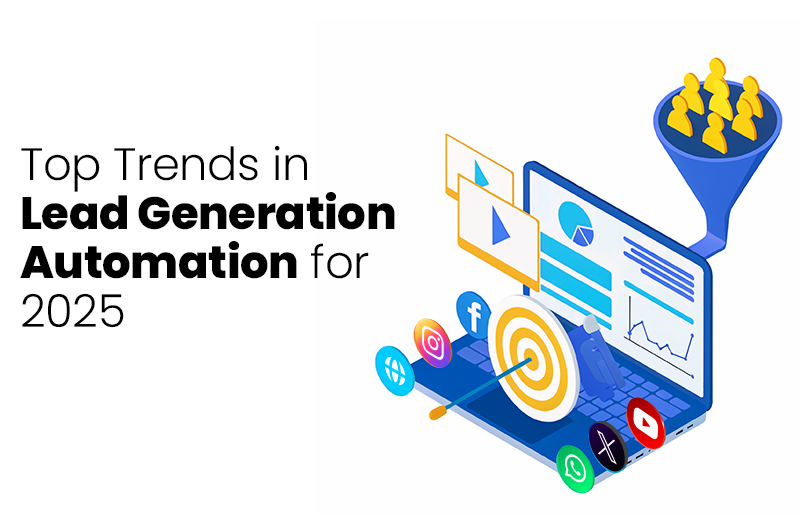Top Trends in Lead Generation Automation for 2025
Finding good leads is getting difficult. Most emails don’t get read, responses are delayed, and prospects lose interest fast. Old methods don’t work anymore, and manual efforts take too much time. Companies require quick, smarter methods of locating and communicating with the right people.
Lead generation automation is changing in a big way. Automation platforms help teams save time and do many more things. Want to know what is working at present? Let us get started!
Smarter Segmentation Through AI
More smart segmentation by AI enhances customer targeting to another level. Rather than targeting basic demographics, AI analyzes buying habits, internet usage, browsing history, and even social media sentiment. These more advanced insights enable rich, detailed customer profiles that reach well beyond age or location, supporting automated lead generation strategies effectively.
With predictive models, AI creates accurate customer segments, which facilitates sending the right message to the right person at the right moment. Marketers are now able to offer more personalized experiences that drive higher engagement, loyalty, and conversions. Smarter segmentation means smarter marketing, and AI is making it possible.
No-Code Lead Automation Tools
No-code lead generation automation tools enable automated tasks and app connections with ease, without writing a line of code. These are for marketers and business teams, not developers. They allow you to create workflows, manage tools, and trigger actions across platforms through intuitive drag-and-drop functionality.
This has turned automation more into an understanding of business requirements than tech proficiency. It is now a matter of knowledge of which apps are participating, what information is important, and who should be knowledgeable. Unlike low-code solutions that can still require IT intervention, no-code tools place the power of automation at your fingertips.
Conversational Lead Capture
Conversational lead capture transforms how companies interact and convert leads in 2025. Unlike traditional static forms, this phenomenon uses AI-driven chatbots and conversational forms to engage with site visitors in real-time. These smart tools, often found in B2B lead generation tools, establish a natural and customized conversation. This capture leads to more effective information and enhances the user experience.
Conversational lead capture is available 24/7 and qualifies leads more quickly, segments leads by response, and directs leads to the correct sales teams immediately using lead scoring automation. It is a cost-saving, scalable method for increasing conversions and optimizing lead generation. This makes it one of the best automation trends to follow this year.
Hyper-Personalized Outreach
Hyper-personalized outreach is set to be a leading trend in lead generation automation for the year 2025. It uses Artificial Intelligence (AI) as well as real-time data to craft highly customized marketing content, services, or products for every individual customer. Automated in many cases, this one-to-one marketing strategy provides a more personalized and relevant experience.
This is the same with personalized social media advertisements, providing tailored solutions like a customized hair care product based on a short quiz. In a world of consumers overwhelmed with choices and constant advertising, hyper-personalized marketing cuts through the noise. It turns ordinary interactions into memorable ones, increasing engagement, loyalty, and conversion rates in a crowded digital market.
Syncing Lead Automation with Sales Teams
- Implemented a system of organized follow-up to hand over only the qualified leads to the sales force.
- Plan regular email campaigns and utilize an omnichannel strategy with a single message.
- Segment based on web behavior, firm size, or industry to provide relevant content.
- Implement lead scoring by actions such as clicks, downloads, or requests for demos.
- Exchange information across departments, like contact numbers, response rates, and purchasing behavior, using AI in lead generation to ensure greater accuracy of data and decision-making.
- Monitor follow-ups after handoff to determine if there are any communication breaks or lost opportunities.
- Send cold leads back to marketing for further nurturing instead of leaving them behind.
- Integrate promotional and sales strategies to enhance deal closures and maximize efficiency.
First-Party Data Collection Strategies
- Customer Surveys: Interview customers to capture first-party data and chart their decision journey.
- Progressive Planning: Employ smart forms that gather small pieces of information at every user touchpoint.
- Interactive Content: Provide quizzes, calculators, and tools that exchange value for insights from the user.
- Create a Community: Inspire user trust via support, growth, and value, not sales.
- Loyalty Programs: Encourage users to share data through rewards and exclusive benefits.
- Conversational Marketing: Use chatbots/live chat to gather insights and navigate users.
- Surveys & Feedback: Conduct incentivized surveys to gain more in-depth audience insights.
- Privacy-First Culture: Establish trust by honoring user privacy and protecting data.
Conclusion
Lead generation in 2025 requires a smarter, quicker, and more precise method. Lead generation automation, powered by Artificial Intelligence-driven segmentation, no-code automation, and real-time conversational capabilities, allows companies to engage meaningfully with the target audience. Personalized approaches cut through the noise, converting basic engagement into long-term involvement.
Closely integrated automation around sales makes processes seamless and reduces missed opportunities. First-party data strategies equip marketers to know customer behavior while establishing confidence. A privacy-first approach builds stronger customer relationships and compliance. Getting ahead means embracing technologies that simplify hard stuff without losing the human touch. Prioritize relevance, efficiency, and value to attract leads that truly convert and stick around.

